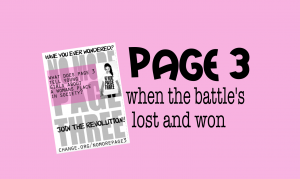
On the bus today, middle-child kicked my foot and rolled her eyes towards the bloke behind me. He was sitting facing her on the seat kitty-corner to hers. I looked over. He was reading a folded-over tabloid newspaper, & a full page black and white photo of a smiling, perky-boobed, naked girl, not much older than herself, was right under my daughter’s nose.
My first reaction was surprise at seeing a ‘Page 3 girl’. Back in 2015 The Sun newspaper stopped their famous ‘Page 3 girls’ feature after years of campaigning from women. Page 3 featured young women who frequently were girls – Sam Fox started topless modelling in 1983 aged just 16. She remembers seeing the photos in The Sun on the bus on the way to her Catholic school, which promptly expelled her.
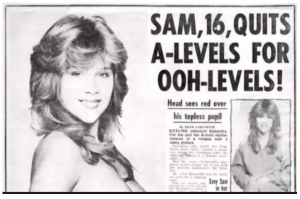
“Wow. You’ve got the face of a kid but the body of a woman,” the photographer had told her.
Sam Fox isn’t much older than me. She was a scandal and a sensation. At the peak of her fame, Sam, who came out as a lesbian in 2003, had bodyguards. I remember the whispered discussions surrounding Page 3, and my grandmother’s disgust that my grandad bought the paper. He would purposefully leave it lying around open on page 3, not to discomfort my sister and myself, but to wind up my grandmother who would clutch her pearls (yes, literally) and talk about the corruption of youth. A more discerning reader, my grandmother got her news from The Daily Mail which she considered to be the height of sophistication.
Sam Fox was not alone in her youth. Maria Whittaker also made her first appearance in The Sun aged 16. She too shared a huge following, with regular TV appearances on The Benny Hill Show, and was named ‘Page 3 Girl of the Year’ in 1989.
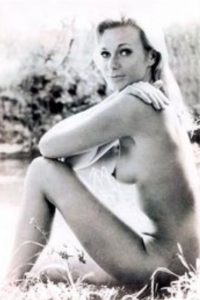 So how did Page 3 begin? On November 7th 1970 The Sun published the first picture of a naked woman to be featured in a daily newspaper. German model Stephanie Rahn was positioned sitting ‘tastefully’ in a field, shot from a side angle with one breast exposed. Editor Larry Lamb claimed she was in her ‘birthday suit’ to celebrate the first anniversary of the paper’s tabloid format. Within a year of starting to publish topless photos, The Sun’s circulation almost doubled to 2.5 million, reaching 4,000,000 by 1978. The Daily Mirror, and later The Daily Star, and The Sport (1991-2010) followed suit and Page 3 became a phenomena.
So how did Page 3 begin? On November 7th 1970 The Sun published the first picture of a naked woman to be featured in a daily newspaper. German model Stephanie Rahn was positioned sitting ‘tastefully’ in a field, shot from a side angle with one breast exposed. Editor Larry Lamb claimed she was in her ‘birthday suit’ to celebrate the first anniversary of the paper’s tabloid format. Within a year of starting to publish topless photos, The Sun’s circulation almost doubled to 2.5 million, reaching 4,000,000 by 1978. The Daily Mirror, and later The Daily Star, and The Sport (1991-2010) followed suit and Page 3 became a phenomena.
In 1986 MP Clare Short criticised The Sun’s Page 3 feature, saying she wanted to “take the pornography out of our press” adding, “I’d love to ban it. It degrades women and our country.”
Ms Short said she faced “giggling sneering MPs” when she introduced a private members bill in 1987 as part of her campaign against pornographic images in the press. The Sun, in retaliation launched its ‘Save our Sizzlers’ campaign – a blatant excuse to run loads more pictures of topless girls
The day before the 1992 election, The Sun printed a picture of a fat topless woman and the warning, “Here’s How Page 3 Will Look Under Kinnock!’.
Hopes that a female editor might view Page 3 differently were dashed when, on her first day as editor of The Sun in 2003, Rebekah Wade walked into the office wearing a pro-Page 3 badge. In response to Ms Short’s continued objections, she published a picture of Clare’s head on top of a topless woman’s body and the slogan ‘Fat, Jealous Clare Brands Page 3 Porn’ and likening her to the back of a bus.
When Short commented at a Westminster lunch, “I might go back to my little Page 3 bill and take the pornography out of the press,” The Sun accused her of “spreading more doom and gloom” and “making everyone’s life a misery”. A bus full of indignant Page 3 models was dispatched to Short’s house within an hour, armed with pictures of themselves and a photographer.
In her 2004 biography ‘An Honourable Deception’ Ms Short wrote, “It is hard not to conclude that The Sun sets out to frighten anyone who might dare to agree that such pictures should be removed from newspapers… I bow to no one in my respect for John Stuart Mill’s On Liberty, but I do not believe that inappropriate sexually provocative imagery, plastered across society, is an example of liberty.”
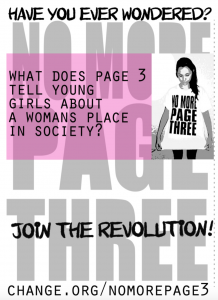 The No More Page 3 campaign was started in 2012 by Lucy-Anne Holmes, with a petition asking The Sun‘s then-editor to scrap the topless photos. Over two and a half years the petition collected 201,000 signatures. Holmes had over-optimistically originally set her sights on a million signatures and to have page 3 down in time for her holiday.
The No More Page 3 campaign was started in 2012 by Lucy-Anne Holmes, with a petition asking The Sun‘s then-editor to scrap the topless photos. Over two and a half years the petition collected 201,000 signatures. Holmes had over-optimistically originally set her sights on a million signatures and to have page 3 down in time for her holiday.
Because sadly, the public does not seem especially bothered.
In 2014 Joshua Allan started a petition for Nottingham Trent’s student Union to ban sales of publications that featured naked women. He collected just 64 signatures. Around the same time, Jonathan Fair petitioned The Star to remove their Page 3, and collected 22.
In July 2013, the then-Prime Minister David Cameron was asked his opinion of Page 3 in an interview for R4’s Women’s Hour.“It is probably better to leave it to the consumer,” said Mr Cameron. “In the end, it’s an issue of personal choice whether people buy a newspaper or don’t buy a newspaper.” When asked how he felt about his own children viewing it, he avoided answering.
In contrast, Caroline Lucas took off her jacket during a 2013 Westminster Hall debate on sexism to reveal a T-shirt bearing the slogan No More Page Three. Speaker John Berkow subsequently banned the wearing of “ostentatious display of badges, brand names, slogans or other forms of advertising of either commercial or non-commercial causes”
In the Guardian in March 2013 Holmes explained why that the arguments,“You don’t have to buy it” and “You’re just jealous” hold little water.
“We’re hearing about 15-year-old girls who have been walking down the school corridor and their boobs are being graded out of 10 compared with the model on the page. They’re not buying it. The mother who walks into a cafe and has to explain to her six-year-old daughter why there’s a naked woman in the Sun? She’s not buying it. The paper isn’t bought and read in isolation, and we all have to live in a society that says ‘shut up and get your tits out’… Imagine if on Page 3, for 42 years, we’d seen scrotums – young, big, hairless scrotums, and now a man was standing up and saying ‘I’ve got sons, and they’re walking down the street, and people are grabbing their balls and saying show us your balls, and they hate this. They’ve got self-esteem issues, and could we just stop the scrotum pictures?’ Imagine if a woman then turned around and said ‘you’re just jealous’. It would be ridiculous.”
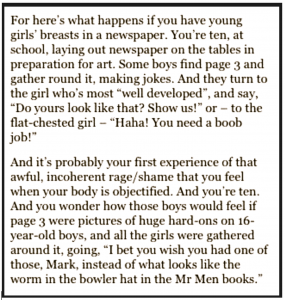 Caitlin Moran was a supporter of the No More Page 3 campaign, making this observation in her book ‘Moranifesto’. You can read her full essay on the reality of Page 3 here.
Caitlin Moran was a supporter of the No More Page 3 campaign, making this observation in her book ‘Moranifesto’. You can read her full essay on the reality of Page 3 here.
On their blog No More Page 3 wrote:
“The Daily Mirror used to feature topless Page Three girls in the 1970s. It dropped the feature in the 1980s because it realised that.. to keep on featuring bare breasts in a family newspaper would make it look like a dinosaur.”
Yet The Sun, The Star and The Sport persisted. So why the focus on The Sun? The Sun newspaper sold around 2,500,000 copies every day. These newspapers were left lying around, shared about: it’s estimated that the paper had a weekly estimated readership of 11,000,000.
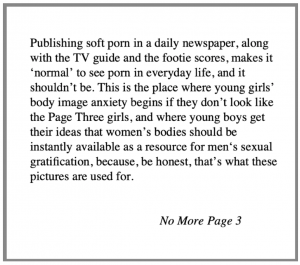
You can read the letter to David Dinsmore, then Sun editor, and see the names of the MPs who supported the No More Page 3 campaign here. The letter concludes, “The Sun publishes Page 3, which reduces women to objects. It reduces men to objectifiers. And it reduces this country to one that upholds 1970s sexist values. We’re better than this.”
In August 2013, the editor of the Irish Sun, Paul Clarkson, dropped Page 3 in its traditional format and began featuring pictures of young women in swimsuits instead.
Girlguiding Advocates said, “It is impossible for girls to nurture their ambitions if they are constantly told that they are not the same as their male equivalents. This is what Page 3 does. It is disrespectful and embarrassing.”
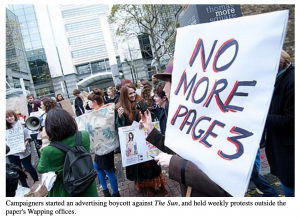 Campaigners started an advertising boycott against The Sun, and held weekly protests outside the paper’s Wapping offices.
Campaigners started an advertising boycott against The Sun, and held weekly protests outside the paper’s Wapping offices.
Journalist Martin Daubney accused some NMP3 campaigners of “anti-woman vitriol” predicting that the campaign would backfire and only leave Sun readers more determined to keep Page 3, spitting out in return, “Short has paved the way for wave after wave of self-appointed, censorious feminists eager to tell us that Page 3 – like the Sex Pistols – is the root of all evil in British society. “
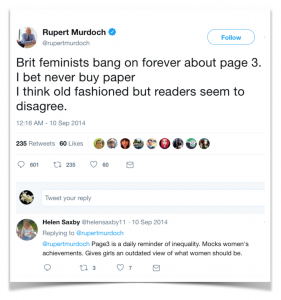
In September 2014, Murdoch described Page 3 as “old fashioned” leading NMP3 campaigners to hope it was reaching the end of its time, and feminist campaigner Helen Saxby to respond, “Page 3 is a daily reminder of inequality. Mocks women’s achievements. Gives girls an outdated view of what women should be.”
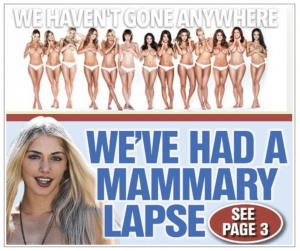 In January 2015 it was reported that the Sun would no longer feature topless young women on page 3.
In January 2015 it was reported that the Sun would no longer feature topless young women on page 3.
“I think the Sun capitulated in the end because we met with Tesco and they agreed to stop displaying newspapers around the sides of their newspaper ‘cubes’ where little children could see objectifying images on the front page,” one campaigner told me yesterday. “I think when the Sun saw the largest supermarket chain was listening to us and actually making changes they knew the tide had turned. I believe commercial interests were behind their decision, not sudden remorse at having objectified half the population since 1970.”
“Today we should be celebrating that, for the first time in 44 years, the biggest picture of a woman in the UK’s most read newspaper will not be of her breasts.” reported Left Foot Forward on 20th January 2015.
“Yesterday morning,” wrote Ceris Aston in the Independent on the morning of 21/1/15, “we woke up to the news that, after two and a half years of campaigning, No More Page 3 was no longer a request but a statement.”
Cause for rejoicing indeed. But hang on, where are we really?
We’re here.
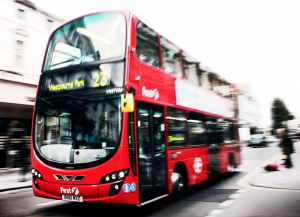 We’re on a doubledecker bus in Camden, hurtling through the 21st century. It’s 2018 and a teenage girl is sitting opposite her mum. The girl is wise and wild, raised a little feminist, and irritated more than intimidated by the old man with the pervy newspaper. She kicks her mum’s foot and rolls her eyes. Her mum looks round.
We’re on a doubledecker bus in Camden, hurtling through the 21st century. It’s 2018 and a teenage girl is sitting opposite her mum. The girl is wise and wild, raised a little feminist, and irritated more than intimidated by the old man with the pervy newspaper. She kicks her mum’s foot and rolls her eyes. Her mum looks round.
He was an older bloke, probably about 70. The picture was black and white, full page. The girl in the photo was probably still in her teens, smiling- of course she was- bare-breasted, her thigh coyly covering her pubic hair, one hand on her hip.
At 4 o’clock in the afternoon, the bus was fairly full. Several people were standing. It would have been really embarrassing to say something. The photograph is a drop in the ocean. Women’s magazines ooze with pictures of topless celebrities on holiday. Sometimes a woman is serenaded for ‘showing off her beach bod’ othertimes her stretchmarks and cellulite are ringed with the red marker pen of shame. ‘Topless is the new normal’ declares The Daily Star’s website, and you know what, maybe they’re right. “Happy NUDE year! Page 3 girls back in fine form as they unveil sexiest poses for 2017 calendar!” coos The Sun online in 2017.
As long as breasts aren’t being used to feed babies, they’re fair game.
I looked away. I looked back. And as I looked back the bloke turned the paper over, smirked and made a half-grunt as his eyes ran up and down the young woman’s body for a few seconds, before he turned the paper round again. The girl in the full-page photo beamed at me vacuously.
Daughter read my mind and mouthed, ‘Don’t!’
If he had turned the page over, the moment would have passed. But he didn’t. I looked at the other passengers on the bus. Nobody seemed to care. I felt so angry and yet so weary that this is actually still considered ‘normal’. Why should girls and young women ever be expected to look at photographs of stripped and objectified peers in public places? To me it seems surreal. Once you notice the trappings of porn culture and patriarchy they are everywhere. Daughter tells me, “I have to just not think about it mostly, or I’d be angry all the time.”
Verging on invisible, I have less to lose.
I looked back at the harmless-looking bloke in the tweed cap.
I realised there wasn’t an option.
I mouthed ‘I’m sorry’ at daughter and turned to the bloke. I spoke loudly but fairly cheerily.
“Excuse me? Would you mind moving your newspaper so that picture of a naked girl isn’t directly under my teenage daughter’s nose? Thank you.”
He was embarrassed and folded over the paper. Daughter was embarrassed. The other women on the bus did not break out into songs of solidarity. Perhaps they thought I was crazy. TBH I have absolutely no idea how anybody responded because I kept my eyes glued to my phone for the rest of the journey.
Did I have to do it? Yes. I really think I did. I would have despised myself if I hadn’t spoken up.
Did it make me feel good at the time? No. It was awkward and embarrassing and difficult.
Do I regret it? No. We should be proud of our moments of courage, however small.
What message do I give my children if I stay silent?
Women, we don’t have to be nice all the time. We don’t have to make it easy for them.
“Courage calls to courage everywhere.”
When you see sexist bullshit, call it by its name.

Hi, I haven’t posted your comment because I felt maybe there was a bit too much identifying information there. I’d be happy to posted a shorter version.
I’m ashamed to say I wasn’t aware this problem was still going on. I thought they’d banned it and the issue was done.
It’s hard to come up with the right analogy for what it would be like if we treated men the same way. I love those examples from Caitlin Moran and the Guardian though. There’s a kind of judgemental shaming aspect (aimed at small breasted women) as well as deliberate groping and assault (for large breasted women). It’s like they’ve made a deliberate lose/lose situation for women that we can’t escape.
The best analogy I can come up with is: it would be sort of like women walked round pulling men’s trousers down to check out their penis size. If they had a small penis, we’d just laugh and tell them to move along. If they have a large penis, we congratulate them before giving them a swift kick in the nuts.
That’s quite close to how I’ve felt when random men have groped me, and on 1 occasion pulled my bikini top off “as a joke”.
It strikes me as woefully ironic that people who supported the no more page three campaign also supported the #jesuischarlie backlash which was, after all, a campaign for freedom of speech irrespective how insulting or offensive the material. Hypocrisy me thinks.